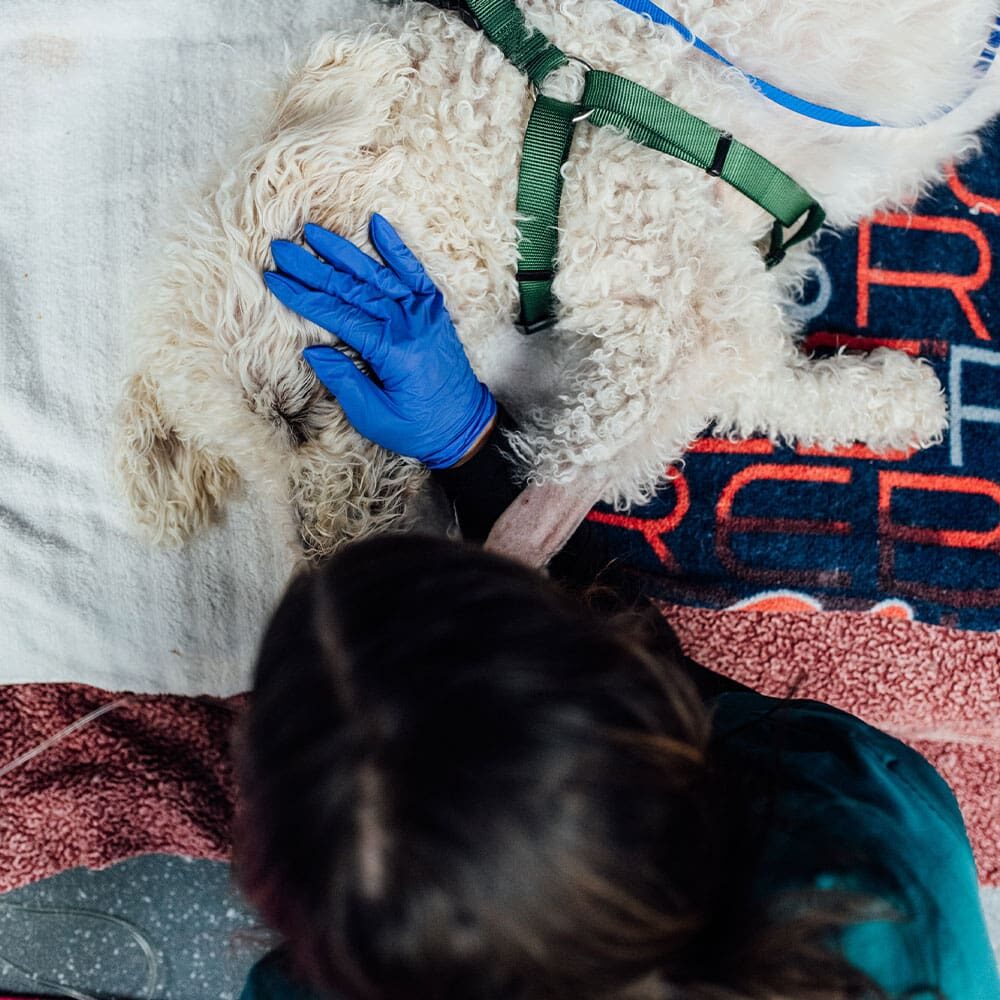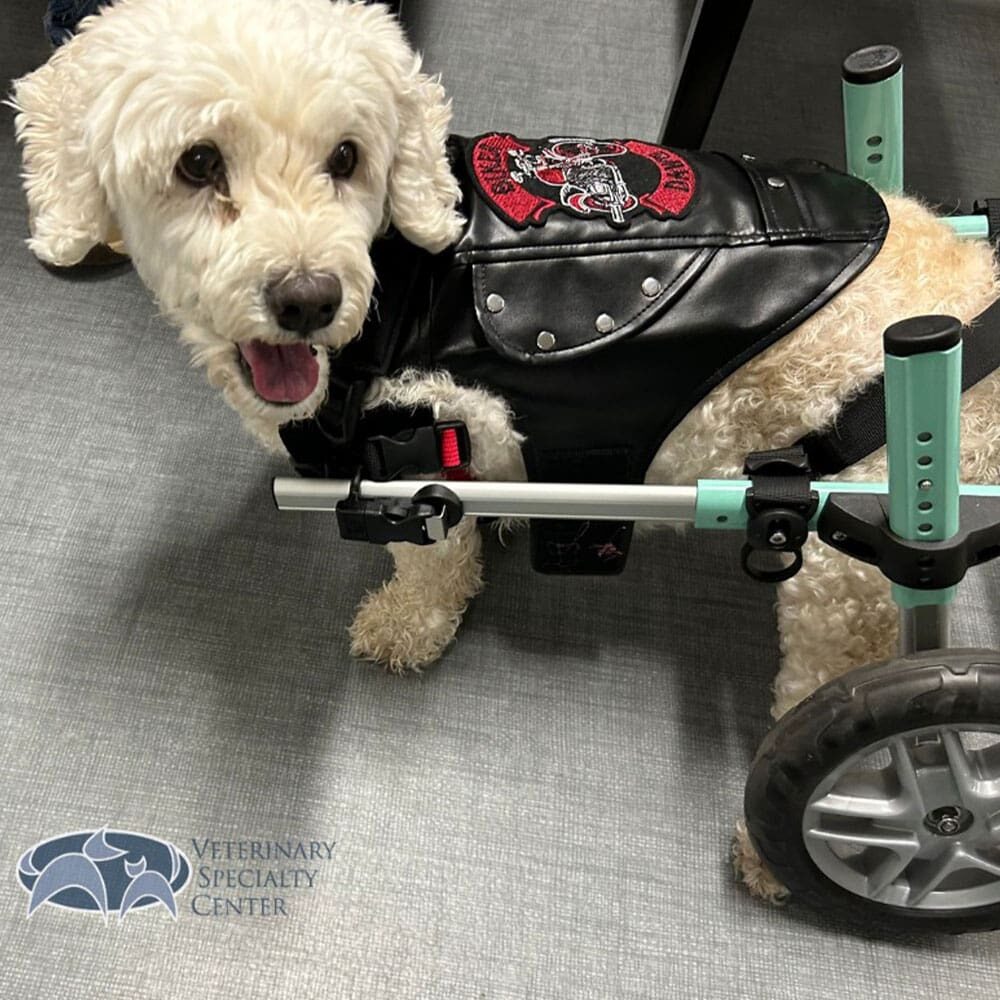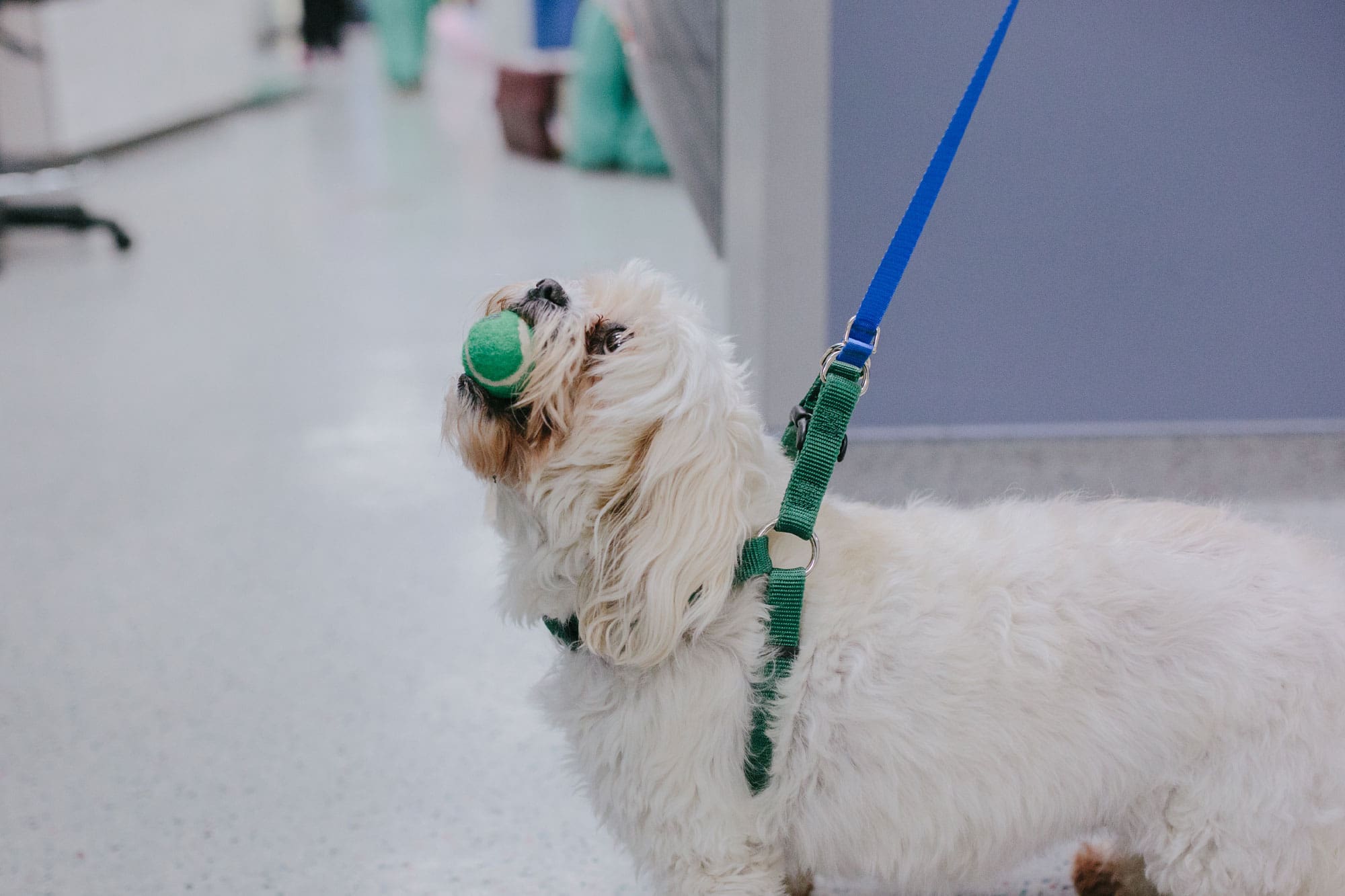Pet mobility carts can help facilitate mobility in pets with orthopedic or neurological challenges, preparing for surgery, healing from an illness or injury, or coping with ongoing or long-term health conditions. The support carts can help facilitate general mobility, reduce stress on joints, muscles, and the spine. By supporting the body and reducing the load on limbs and spine, they can also facilitate rehabilitation following orthopedic or neurological injury, allowing patients to focus more on re-learning how to use the correct muscles and motions rather than strengthening maladaptive postures and gaits.
To ensure your pet has the best opportunity to feel comfortable and use their cart appropriately, it is important our rehabilitation team has determined a cart is a good option for your pet during their Initial Consult. We will review the types of carts (e.g., rear-wheel, quad cart, front-wheel, adjustable) and which cart option is best for your pet and their needs for rehabilitation and/or long-term use. Our rehabilitation team will collect preliminary measurements of your pet to determine the size of cart required. Then, we’ll schedule a formal cart fitting appointment when the cart arrives so it can be custom fit to your pet and functions as needed for your pet.
Common Conditions That May Benefit from Pet Mobility Carts
Carts can be beneficial to dogs and cats with a wide range of conditions, including:
-
Significant Arthritis
-
Degenerative Neurological Conditions
Degenerative Myelopathy (DM), Geriatric Onset Laryngeal Paralysis Polyneuropathy (GOLPP)
-
Spinal/Back Injury or Intervertebral Disc Disease
-
Neurological Injury
-
Paresis (weakness) or Paralysis
-
Limb Deformities or Amputations
-
Hip Dysplasia
-
Surgery or Illness Recovery




Walkin’ Wheels Carts
At VSC, we highly recommend Walkin’ Wheels Carts by Handicapped Pets, as these carts are easily adjustable and are customized to fit your pet’s specific needs. Our team offers cart measurements for our patients who would like to purchase or potentially rent a mobility cart through Walkin’ Wheels carts. While we can facilitate communication with Walkin’ Wheels for the proper cart size, you will order the cart directly from them. We can also measure your pet for other brands with a formal cart measurement appointment.
For any purchased or rented cart, a cart fitting appointment is necessary to customize the cart to your pet and their needs. (Please do not put the cart together, just bring it with you!) While carts seem like they might be easy to put together and adjust, they actually are not. If you introduce your pet to a cart that is either not properly assembled or fit for their body and needs, the likelihood they will reject the cart is high. To reduce this risk, please let us assemble and fit the Walkin’ Wheels cart for you at a Cart Fitting appointment.
A limited number of Walkin’ Wheels carts are available for rental on a month-to-month basis. This option allows patients to use the cart and assess whether your pet adapts well to the cart. This trial period gives you time to see if your pet is comfortable using it. Some pets only require short-term support for rehabilitation, while those needing extended recovery may benefit more from purchasing a cart.
For any purchased or rented cart, a cart fitting appointment is necessary to customize the cart to your pet and your pet’s needs. (Please do not put the cart together, just bring it with you!) While carts seem like they might be easy to put together and adjust, they actually are not. If you introduce your pet to a cart that is either not properly assembled or fit for their body and needs, the likelihood they will reject the cart is high. To reduce this risk, please let us assemble and fit the Walkin’Wheels cart for you at a Cart Fitting appointment.
A limited number of Walkin’ Wheels carts are available for rental on a month-to-month basis. This option allows patients to use the cart for a month of rehabilitation exercises and assess whether your pet adapts well to the cart. This trial period gives you time to see if your pet is comfortable using it. Some pets only require short-term support for rehabilitation, while those needing extended recovery may benefit more from purchasing a cart.
Fees
All carts require a separate Cart Fitting appointment (purchased or rented) and Cart Fitting Fee. Rentals require a deposit, which is refunded if the cart is returned on time and in good condition. If you're considering purchasing a cart, check with your pet’s insurance provider to see if coverage is available. In many cases, insurance companies require a formal prescription and that the purchase be made through a veterinarian.
Our Process
If your pet is considered a good candidate for a cart, our team will create a therapeutic plan to maximize your pet’s comfort and aid their recovery. Along with our various rehabilitation services, we will fit your dog or cat for their cart and guide you in getting them accustomed to their new assistive device.
Pets using assistive devices like carts may appear to favor their unaffected limbs—not out of laziness, but because their desire to move and engage overrides any hesitation. This natural motivation supports their physical rehabilitation, not hinders it. Incorporating both psychological enrichment and targeted physical exercises in the cart helps promote progress and recovery.
Check out the helpful videos below to see the cart fitting process, as well as how to place your pet into different kinds of carts with real VSC patients.
Cart Fitting for a Tripod
Watch Remi’s pet mobility cart fitting as she waits for surgery to correct a luxating patella when she is old enough.
Cart Fitting & Placement for DM/IVDD
Below is Squints’s fitting and placement in his cart. He has Intervertebral Disc Disease (IVDD) and Degenerative Myelopathy and will be using his cart to help him walk as his diseases progress.
Loading and Unloading Your Pet From Their Cart
Like any new change, your pet will need time to adjust to their cart and this new way of moving. To help them become accustomed to using the cart, we recommend creating a routine for loading and unloading your pet into the cart. This can help you ensure they are in the cart properly and that they will get the best use out of it.
For the first two days, limit cart use to 10–15 minutes with at least two hours between sessions. Short, positive experiences help build comfort. After each session, gently massage the armpits, hind limbs, and belly to restore blood flow to areas compressed by the harness. Check for pressure sores where the straps and harness touch your pet's skin. If their skin stays clear after 2 days, gradually increase cart time by 15 minutes every 2–3 days, up to 30–45 minutes per session.
See some helpful instructional videos below.

